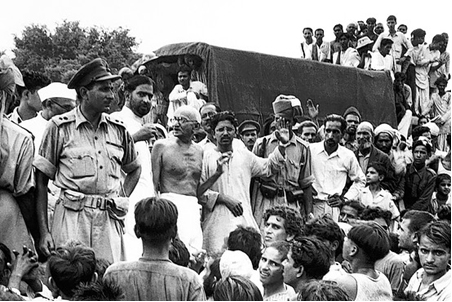Natabar Khuntia
Mahatma Gandhi returned from South Africa to India in January 1915 at the request of Congress stalwart Gopal Krishna Gokhale, who introduced him to Indian issues, politics and people. He joined the Indian National Congress some time after Gokhale passed away.
A problem Gandhi went on to take interest in and resolve was the forced cultivation of indigo. British zamindars at Champaran in North Bihar were forcing ryots to cultivate indigo under the tinkathia system. It meant each farmer had to cultivate indigo on three kathas out of the 20 kathas (an acre) let by zamindars. The zamindar could select where indigo should be planted and what price should be paid for the labour. The system reduced farmers to serfs.
Gandhi by then had achieved some success with movements for peasants and the oppressed classes, and in getting justice from the British. But it was at the All India Congress Committee meeting at Lucknow in 1916 that he was apprised of the tinkathia system by the indigo farmer from Champaran, Rajkumar Sukla. The farmer requested Gandhi to visit Champaran, which the latter had to deny then owing to prior engagements. But he promised to visit Champaran later.
In early 1917, Gandhiji visited Champaran as promised. Before hearing the ryots, he deemed it necessary to meet indigo planters and the Commissioner of the Division to understand their perspective of the matter. But planters told him he had no business to stand between them and their tenants; and the Commissioner ordered Gandhi to leave the area forthwith.
But Gandhi defied the order and moved court at Motihari over the matter the next morning. When the trial began, the government pleader, the magistrate and district officials pleaded for the case to be postponed; but Gandhi insisted that the trial should continue and it did. He read a prepared statement, whose gist was that he was there as requested by indigo farmers and that he had visited them and planters and government officials themselves to understand the state of affairs. He averred that he did not intend to instigate people against the government and, therefore, had no alternative but to disobey Section 144 of CrPC then imposed.
Meanwhile, the district administration received instruction from the Lieutenant Governor to withdraw the case against Gandhi and the collector offered all help with his inquiry, including manpower and documents as and when required.
On this decision Gandhi wrote: “The country thus had its first direct object-lesson on Civil Disobedience.” But Gandhi sensed displeasure among government officials and planters, although they appeared cooperative on the outside. On a hunch that they might be waiting for an opportunity to detract the inquiry, Gandhi requested newspaper editors to not send any reporter to cover the inquiry and promised he would regularly send them regular reports to prevent politicising the inquiry, which could derail it.
Gandhi met ryots and recorded their statements about problems with indigo cultivation. He allowed an officer of the CID to accompany him to assure the government that no political activity was part of the exercise. Through his interactions with farmers and occasional meetings with planters and government officials, Gandhi learnt the situation on ground.
Soon, then Lieutenant Governor Sir Edward Gait constituted an inquiry committee and requested Gandhi to be a member in it. He agreed on condition that if recommendations of the committee did not solve problems of the ryots, he would side with ryots and take the next step. The committee’s recommendations turned out to be in favour of indigo farmers and the planters had to return a portion of the exactions they had made.
Gandhi experimented with satyagraha in the indigo fields of Champaran and succeeded. Since then satyagraha became an indispensable tool in the freedom movement.
Leaders of farmers’ movements today should follow Gandhi’s method. They should study problems intimately and bring out workable alternatives before authorities and adopt non-violent means to achieve their goals.
The writer is an agro-banker and columnist. e-Mail: natabarkhuntia1@gmail.com.
